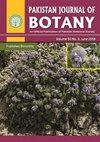Influence of phyto-mediated zinc oxide nanoparticles on growth of (Zea mays L.)
IF 0.9
4区 生物学
Q4 PLANT SCIENCES
引用次数: 0
Abstract
The agricultural sector is being affected by environmental extremes nowadays and causing issues to food security globally. To resolve these issues, researchers are taking much interest in nanofertilizers and related products nowadays. Maize is known to be an important cereal crop after wheat and rice worldwide. Lack of micronutrients especially zinc in cereal crops is a problem in today’s agriculture. The use of plant-based zinc nanoparticles in the form of nano-fertilizers can reduce this problem. The current study mainly focuses on the green synthesis of zinc nanoparticles and their effects on Zea mays growth. The formation of Zinc oxide nanoparticles was confirmed by UV-Vis spectroscopy, Fourier Transform Infrared spectroscopy, Scanning Electron Microscopy, and particle size analysis. The effect of concentration of synthesized zinc oxide nanoparticles (0.2-1000 mgL -1 ) was studied on germination, seedling parameters (root and shoot length, fresh, and dry seedling weight), and biochemical parameters (Chlorophyll, sugar, proline, phenolic, and protein content) of Z. mays seeds under lab conditions. The pot experiment was then conducted with the selected concentration of zinc oxide nanoparticles from the petriplate experiment and zinc sulfate salt as a control. Growth and yield parameters were studied for grown maize plants. Results indicated that spherical-shaped zinc oxide nanoparticles with an average size of 68-89nm were obtained, where phenolics were the main chemicals present at the surface of NPs. Zinc oxide nanoparticles improved seed germination significantly (92%) as compared to the control treatment (68%). Root length (26.6cm±0.9) and shoot length (12.1cm ±1) were also enhanced in pots of nanoparticle treatment as compared to control i.e., 23.4±0.9 and 7±1 respectively. Zinc oxide nanoparticles also enhanced sugar content (455ug/g±9.08), protein content (17.1µg/g±0.2), proline content (343.71µg/g±1), and chlorophyll content (682.96ug/g±44) of maize seedlings as compared to control 155, 10.3, 206, 252ug/g of plant material respectively. Results of the pot experiment showed that Zinc oxide nanoparticles treatment significantly increased the germination percentage (25%), shoot length (50%), root length (22.2%), leaf area (34.3%), cobs per plant (33%), chlorophyll content (18.4%), Sugar content (2.5%), Phenolic content (3.4%), proline content (36.3), MDA content (20%), starch content (33%), and zinc content (110%) significantly as compared to control. Hence our results indicated that zinc oxide nanoparticles can be utilized as nanofertilizers to induce early germination in plants and to enhance seedling growth and biochemical processes for Zea mays .植物介导氧化锌纳米颗粒对玉米生长的影响
本文章由计算机程序翻译,如有差异,请以英文原文为准。
求助全文
约1分钟内获得全文
求助全文
来源期刊

Pakistan Journal of Botany
生物-植物科学
CiteScore
2.40
自引率
8.30%
发文量
218
审稿时长
8.4 months
期刊介绍:
The Pakistan Journal of Botany is an international journal for publication of original research in plant science. Work on all plant groups, including fossil plants, is published. The journal publishes in the areas of: ecology and ecophysiology; conservation biology and biodiversity; forest biology and management; cell and molecular biology; paleobotany; reproductive biology and genetics; mycology and pathology; and structure and development.
 求助内容:
求助内容: 应助结果提醒方式:
应助结果提醒方式:


